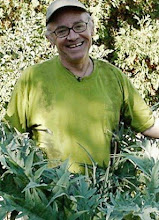
A potato tower and the first planted potatoes
 The sprouted beets and the radish markers
The sprouted beets and the radish markers The parsnips pushing up
The parsnips pushing up The future tomato crop
The future tomato crop Pole placement
Pole placement Pole pounding - tough and noisy
Pole pounding - tough and noisy Rows ready for anchor twine
Rows ready for anchor twine
 I planted three each of my fourteen varieties.
I planted three each of my fourteen varieties. Here is the finished planting with some repeats and our favorites in the last row.
Here is the finished planting with some repeats and our favorites in the last row. Time to cover peas with soil to keep their roots cool
Time to cover peas with soil to keep their roots cool The compost bin is filling with leafy garden refuse.
The compost bin is filling with leafy garden refuse.
A very busy week. Many planted seeds are sprouting nicely. The parsnips broke ground and the beets have too. The spinach crop is almost over. Last falls planted spinach has provided us with a harvest since March and we have been eating it at least five times a week. I hate to make it into compost but I need the space for a pepper crop. Radishes and lettuce planted this spring are also part of the our harvest along with the sorrel which is bolting so that those seed stalks need to be removed to keep the plants producing edible leaves.
This years tomato crop is in the ground. I have five rows of twelve plants per row for a total of sixty tomatoes - yes sixty! We will enjoy every one of those tomatoes as fresh, juice, frozen, or dried. I added another row this year because the plants I grew were so good I hated not to give them space. I gave a fair number of plants away at garden club on Wednesday and still have few more that I will pass along if I can. Everyone has space for just one more tomato plant. As the photos show we do a post and string method to keep the plants growing vertically and use our space efficiently. As I go along I will show each step of the process. For now, the rows have four iron posts with twine secured on the bottom to act as an anchor string for the vertical strings that will later support the growing tomatoes. As I add more strings and wind the tomatoes up the strings, I will show you how I do that; along with the way to remove the suckers that the plant produces. I stopped using cages years ago. I did not find that method near as productive as this string method and even with pruning to two leaders per cage, I still did not like the production. Additionally, I had all those bulky cages to store in the garden all winter. This post and string method works so much better for me.
We are also attempting to grow potatoes vertically this year. I have started two towers and will keep you posted as to how that is going. I developed the tower by making a sandwich of straw and compost and as I add potatoes I intend to add more layers of straw and compost. I think each tower will have eight to ten plants. We have, I think, six or eight varieties of potatoes to go into our towers. This weeks planting is Princess LaRatte Fingerling potato.
The apple flowers have all fallen and so I did my first and only spray application this week. To attempt to foil the plum curculio I sprayed my trees with Sevin. I will begin bagging the fruit as it sizes in another week. Three of the grafts seem to have taken but a few more weeks will be needed to see what really has happened. I always hope for the top graft to take but that is not always the case.
The bagged of the apples will be the subject of one post with a video to help you see how we do the selecting of the fruit and bagging of the apples. One spray application means our apples do not qualify as organic fruit. But as the fruit is bagged to prevent other pest damage, I feel it qualifies for what could be called an ECO-apple. The process is as close to pesticide free as I can make it in my garden. I have been bagging apples for the last eight to nine years and have had good success with this process. In the next two weeks it is very important to keep the plum curculios off your fruit so that you can bag the best fruits that have been pollinated. This might mean a single spray application. But, if you bag your apples, that will be the ONLY spray you will need. Traditionally, home-grown un-bagged apples have been subjected to bi-weekly spraying during the growing season. I feel the "spray once and bag" method works far better for our family.
This week I am off to Canada so I will have a skip in the blog as I will be - GONE FISHING
Happy Gardening









































